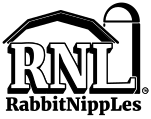Another important aspect of raising rabbits is their health. If you are raising rabbits on either a small or large scale, you must know a little about their health and remedies associated with various ailments. This is not going to be an all-inclusive health section, but a very simple area to help with some of the most common ailments. It will also be an ever-growing section. Please check back regularly. Also, we are not veterinarians and so the information here are suggestions only and should not be interpreted as professional medical advice.
Although disease and sickness is a natural part of life and can never be completely eliminated, it can be kept to a minimum. This is done through preventative measures. And disease prevention is far better than disease treatment.
Quarantine
First and formost, when you purchase a new rabbit, regardless of where it comes from, you will want to quarantine that rabbit(s). When you are setting up your rabbitry, make sure you take the extra time and resources to set up a couple cages in a separate area, away from the rest of your herd. This will be the quarantine area, used for new rabbits (for observation) and for sick rabbits (during treatment). DO NOT skip on this critical component of your rabbit raising system. If you do not do this, you WILL eventually wish you'd taken the time and spent the extra money to do so, sometimes at the expense of your entire herd.
Get into the habbit of not trusting anyone when it comes to the health. Always do your own observations for a 30-day period after obtaining new rabbit(s). Some of the things you'll be observing:
- Sneezing (prolonged, not just once on a dusty day)
- Nasal discharge (note the color of the discharge as well)
- Matted hair on inside of front legs (from wiping nose or eyes)
- Ears (gunk build up inside ears, usually from ear mites)
- Eyes (discharge, redness, wet hair around eyes, fur loss around eyes)
- Breathing (any raspy, struggled or weezing/liquidy sounds)
- Feet (sores, fur loss)
- Teeth (buck, extra long or anything out of the ordinary)
- Weight (weight loss or other significan changes)
- Feces (diarrhea or other out-of-ordinary dropping)
- Anything else that you might notice to be "not normal"...
Careful observation over the first 30 days will ensure that there are no problems easily observed. Of course this will not catch every problem that may be present, but will allow you to catch most of them before the rest of your herd is exposed and possibly infected.
Also be sure to wash your hands and if necessary, change clothing that might have been in contact with them during this time before handling your other rabbits. It is recommended that you take care of your regular herd first and then your quarantined rabbits second to avoid any possible cross contamination.
Supplies
We recommend you always have the following items (health and sanitation related) on hand when raising rabbits:
- Ivermectin paste (ear mites)
- Mineral Oil (if you don't like the Ivermectin option for mites)
- Vanodine (safe disinfectant spray - multi use)
- Vetericyn (weepy eye, nestbox eye and multiple other uses)
- Corid (coccidiosis and some other ailments)
- Vi-Tal or Acid-Pak 4-Way (probiotic)
- Apple Cider Vinegar (many uses - in water)
- Rolled Oats (used along with probiotics for digestion problems)
- Timothy Hay (used with rolled oats for digestive aid)
- Blu-Kote (first aid spray for sore hocks and wounds)
- Clorox Bleach (cleaning/disinfecting)
* Vanodine V-18 (or Vanodine FAM) can be found here (3rd party source, we have no affiliation with the supplier, but have purchased through them previously): http://www.bunnyrabbit.com/price/medicate.htm#Vanodine
____________________________________________________
AILMENTS
Ear Mites
Ear mites are a common problem in many rabbitries and if overlooked, can be not only extremely painful, but deadly for infected rabbits. Rabbits with this problem will often scratch at their ears and shake their heads.
Treatment: Some recommend rubbing either mineral oil, olive oil w/ a little vitamin D mixed in or buying ear mite solution in the ear. Repeat every other day for approximately 10 days. Each treatment, massage the ear to allow total covering. Swab out gunk. Repeat as needed. (This treatment "drowns" the mites).
Another extremely effective treatment is to give a pea sized application of Ivermectin paste orally (there are also injectable and topical versions) to the rabbit. Then 10 days later, repeat this to eliminate hatchlings since the first application. Make sure the Ivermectin doesn't have any other de-worming additives that would harm the rabbit. This is highly effective for 6 months to a year and the recommended process.
Weepy Eye (Conjunctivitis)
Weeping eye is identified by inflamed eyelids or discharge from the eye. You may also notice the fur starting at the eye running toward the nose is wet and matted down and possibly falling out. It can be caused by various things anywhere from clogged eye ducts to bacterial infections.
Treatment: A very effective treatment for this is Vetericyn. It comes in both spray and dropper options and kills bacteria, fungi, viruses, spores, etc. and is very safe. Vetericyn can be used for various other ailments as well.
Coccidiosis, Intestinal
This is the most common disease in rabbits and is classified as a parasitic disease, since the cause is a microscopic protozoa. Complete extermination of the protozoa is very difficult once an animal is infected. These protozoans are classified as "coccidia" and those that infect the liver and different than those that infect the intestines. Symptoms may include loss of appetite, pot belly, diarrhea, and inability to gain weight. Although in mild cases, these symptoms may not be easily observed.
Treatment: Follow good sanitation management and raise rabbits on wire floored cages that allow droppings to fall through down and away from rabbits (prevention trumps treatment, especially with Coccidiosis). Sulfaquinoxaline administered continuously in the drinking water (0.04% for 30 days) prevents clinical signs of hepatic coccidiosis in rabbits heavily exposed to Estiedae . However, it may not prevent the lesions. Sulfaquinoxaline may also be given in the feed at 0.025% for 20 days, or for 2 days out of every 8 until marketing. Because feed-grade sulfaquinoxaline can be difficult to obtain, liquid sulfaquinoxaline is used more commonly. Withdrawal time is 10 days for rabbits used for food. Other coccidiosis treatments do not have approved withdrawal times for meat rabbits. Other sulfa drug treatments include sulfadimethoxine (0.5-0.7 g/L drinking water) and sulfadimerazine (2 g/L drinking water). Other coccidiostats that may prove to be effective include salinomycine, diclazuril, and toltrazuril. Treatment is best administered for a minimum of 5 days and repeated after 5 days. Rabbits that are treated successfully are immune to subsequent infections.
Pasteurella Multocida (Snuffles)
This ailment is a most feared problem with serious rabbit breeders as there is no permanent cure. It is caused by a bacterial infection and often results in sneezing, white milky nasal discharge, matted down front paws (the inside) from wiping nose and eyes and sometimes more serious breathing ailments.
Treatment: There is no "cure" but can be treated by antibiotics (penicillin or Baytril). Consult a doctor before treatment as some versions of penicillin can kill rabbits). Most breeders will cull rabbits with this infection as it is highly contagious and passed along to their young.


More Coming Soon...


